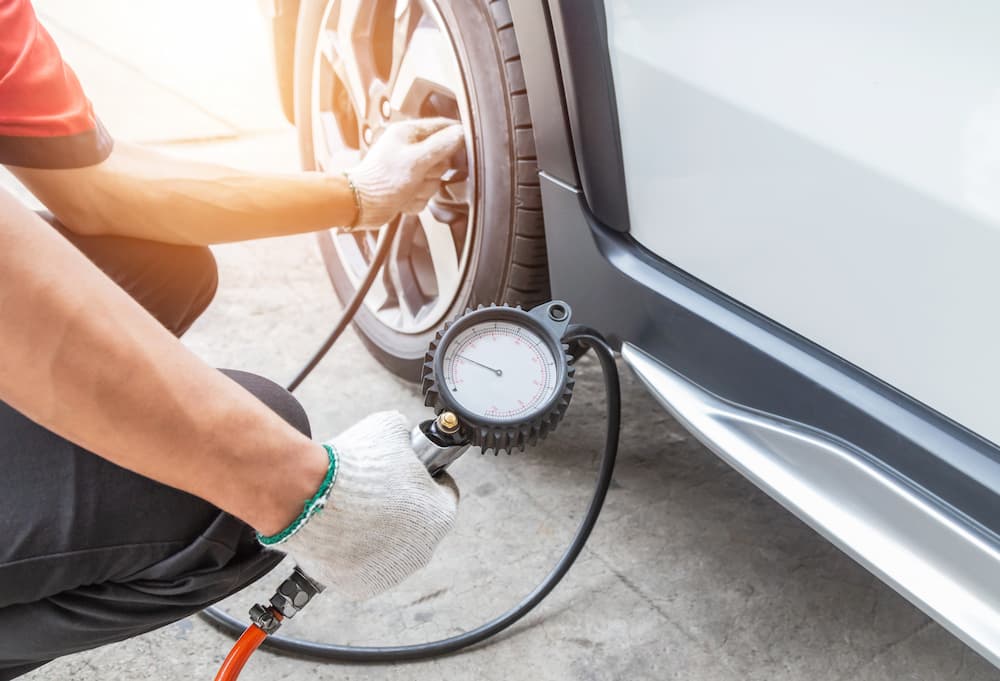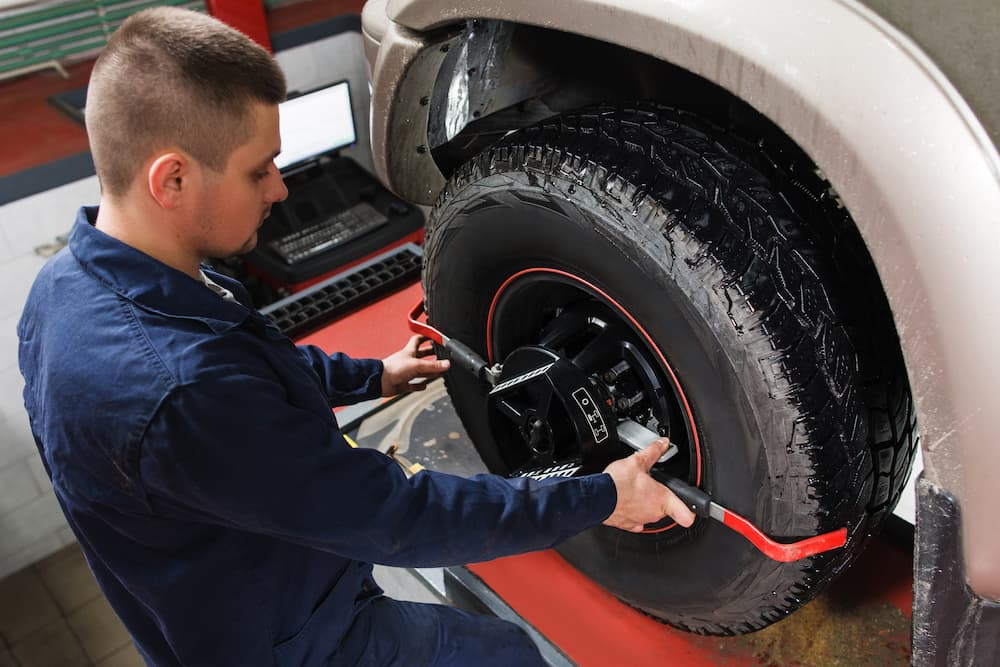How often do you think about your tires? For most of us, it’s not until we’re alerted to low tire pressure or we have a flat tire that’s left us stranded on the side of the road that we genuinely think about the four essential components to our safety behind the wheel. The only point of contact a vehicle has with the road is its tires, after all, making them critical long before unexpected repairs take you to your local auto repair shop.
Tires are expensive, particularly good tires that enhance your car’s performance and engineer confidence behind the wheel. So, why wouldn’t we do everything possible to extend their longevity? Proactive tire maintenance is critical to extending the life of your tires and protecting your investment. Here’s everything you need to know about tire maintenance, from tire pressure and tread wear to tire rotations, alignments, and balancing.
#1 Monitoring Tire Pressure
While you can use a traditional tire gauge, most vehicles make monitoring the air pressure in your tires a lot simpler with digital tire pressure monitoring systems. This technology constantly monitors the air pressure in the tires, presenting the data via the digital driver display. The technology also alerts you to underinflated tires, minimizing the potential for experiencing sudden, hazardous driving conditions.
But why is monitoring the tire pressure critical? An underinflated tire is extremely dangerous because it alters how well your vehicle performs and responds to steering input and braking. At the same time, lower air pressure in the tire causes the sidewall to flex, generating more heat and heightening the risk of a blowout by exacerbating wear on the tread. Since an underinflated tire isn’t making optimal contact with the road, it also forces the engine to work harder and burn more fuel. This costly expense ultimately leads to needing a new tire altogether.
Overinflated tires aren’t as hazardous as underinflated tires, so most tire pressure monitoring systems only alert drivers to the latter. However, an overinflated tire can also lead to issues. For example, tires with too much air make more contact with the road in the center of the tread, causing it to wear faster and impacting the quality of the ride.

#2 Measuring Tire Tread
Monitoring the tread on your tires is also critical and easier than most people imagine. But why is the tread on your tires so important? The tread is how your tires grip the road as you drive, making bald tires extremely hazardous because there’s no tread to maintain traction.
Fortunately, monitoring the tread on your tires is something your local auto repair shop will do with most routine services. It’s also something you can do at home with some loose change and a little bit of know-how. If you have a penny, insert the coin with President Lincoln’s head upside down and facing you. If you can’t see the top of Lincoln’s head, the tread on your tires is good, but if the top of his head is exposed, then it’s time for new tires. You can do the same test with a quarter, using President Washington’s head as the guide. If the tread touches Washington’s head, your tires are good, but if it doesn’t touch, it’s time to start tire shopping.
If you don’t have loose change, you can look for the tread wear indicator on your tires. This indicator is built into the tire, less than an inch from the bottom of the groove in the tread. When the groove wears evenly with the indicator, you’ll know it’s time to replace your tires.
#3 Tire Rotations
Knowing the significance of tire tread makes it easier to understand why tire rotations are integral to extending the life of your tires. Rotating your tires is a routine service often performed with every oil change. During a tire rotation, technicians reposition the tires on your vehicle in a specific pattern, depending on the drivetrain, the types of tires, and if you can rotate in a full-size spare (like the spare on a Jeep Wrangler). But what effect does rotating have on your tires?
The tires on your vehicle have the same job–to make contact with the road as you drive–but they wear differently. For example, the front tires on a front-wheel drive car can see more wear and tear because they use more torque and friction to accelerate, brake, and turn the vehicle. By rotating the tires, you’re balancing this wear across all four tires and promoting even tread wear, which improves performance, promotes better fuel efficiency, and helps your tires last longer.
#4 Tire Balancing
While tire rotations are part of your vehicle’s routine maintenance, tire balancing is not and is typically performed when you buy a new set of tires or experience specific performance issues on the road. For example, you may feel a vibration in the steering wheel, seat, or floorboard. Vibrations in the steering wheel can indicate that one of the front tires is imbalanced, whereas vibrations in the floor or seat typically signify an issue with the rear tires.
There are two types of imbalances–static and dynamic. Static imbalances are those when a heavy or light spot doesn’t let the tire roll evenly, which causes the tire to vibrate up and down. Alternatively, dynamic imbalances occur when there’s uneven weight on one or both sides of the tire’s centerline. This imbalance produces a sideways or lateral vibration.
Technicians correct these issues by removing each tire and putting it on a balancing machine. The machine spins the tires to determine the imbalance, providing the technicians with how much weight is needed and where it needs to be placed. Once the imbalance is remedied, you get to reap the benefits of a smoother ride and less wear and tear on the tires and drivetrain.
#5 Wheel Alignments
Wheel alignments are similar to tire balancing services because they are less routine than tire rotations. Moreover, alignments are misleading because they have less to do with your tires and everything to do with your suspension, which connects your wheels and tires to the vehicle. So, what happens during an alignment, and why is it essential to extend the life of your tires?
Your suspension takes a beating anytime you’re behind the wheel, but sometimes potholes, fender benders, and other impacts can cause things to misalign slightly. When this occurs, you may notice uneven tread wear, that your vehicle pulls to the left or right, or that driving straight requires turning the steering wheel off-center. When this happens, getting an alignment should be your top priority.
During an alignment, technicians will measure the camber, toe, and caster angles of the suspension. These angles look at how the tires are positioned. For example, the camber angle measures the inward or outward tilt of the tires from the front of the vehicle. The toe angle determines whether the tires point in or out from a top-down view (like looking down at your feet with your toes pointed in or out) and the caster angle measures the tire’s positioning from the side and if they’re angled toward the front or rear of your vehicle.
Technicians measure and modify these angles based on the manufacturer’s recommendations for your make and model. When aligned, your tires are correctly positioned, and the tread wears more evenly. In turn, your vehicle also handles better and more efficiently.

Proper Tire Maintenance Makes Driving Better
Proactive tire maintenance is easier than ever when you have a reliable auto repair shop on your side and the know-how to keep an eye on things like tire pressure and tire tread. While these may seem minor, they greatly impact your safety and how your vehicle performs both in terms of your daily driving experience and for things like fuel efficiency. Moreover, proactive tire maintenance can help you extend the life of your tires, meaning you get the most out of your investment every mile ahead. Considering just how important your tires are for your safety and experience on the road, it’s worth taking a little time to make sure they’re in great shape and having service performed on them when the time comes.

